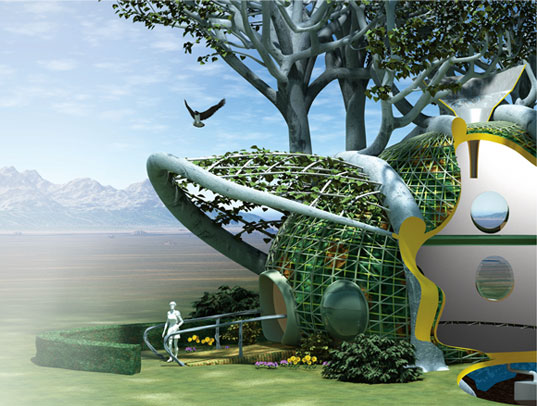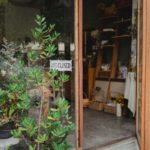
Fab Tree Hab is a hypothetical eco-friendly residence at MIT designed by Mitchell Joachim, Javier Arbona and Lara Greden. Fab Tree Hab Village is a residential concept that aims to replace the outdated buildings of Habitat for Humanity.

Fab Tree Hab goes beyond sustainable construction and so-called green design, building with materials that have less impact on the environment and human health. Rather than using materials that have a low impact on the environment and human health (the magnitude of the impact may remain uncertain), Fab Tree Hab aims to protect and utilize ecosystems as a source of sustainability in the built environment. As a direct contribution to the accumulation of knowledge in the fields of architecture and urban design, Fab Tree Hab embraces ecology as the main engine of life.
Fab Tree Hab breaks down our traditional concept of the home and establishes a new symbiosis between the home itself and the surrounding ecosystem. A holistic abode that takes into account the surrounding landscape The Fab Tree Hab is built using an ancient horticultural technique in which plants and trees are grafted onto each other so that they literally keep growing. The construction of the Fab Tree Hab will begin as an experiment, and it is expected that the concept of reconstruction will later take on a new architectural form: the interdependence between nature and people.
These buildings will improve the quality of life by paying tribute to nature rather than exploiting it. Imagine a society based on the slow growing of trees for housing instead of the industrial production of cut timber. Our vision is to grow houses naturally with a new form of tree culture without accelerating tree growth. With the idea of alleviating the burden humanity places on the environment through conventional construction, by growing “live, breathe” tree house.
The walls will be made from trees that will grow around the recycled wood scaffolding that will shape the structure and be subsequently removed. To increase the control, depth, and accuracy of this construction method, a conventional computer designs the use of scaffolding on which native trees can be grown. The internal structure is made using blocks of clay and straw as building materials, as well as trees such as elm. The trunks of inosculate or self-grafted trees such as elm, live oak and dogwood are the supporting structure, and the branches form a continuous mesh frame for the walls and roof.
The project uses the weaving technique, a method of planting trees in a row, designed to transport heavy loads using trees such as elms, live oaks and dogwoods as structures. Plantware is a company that advises on the use of aeroponics with gazebos. The Fab Tree Hab is based on the use of self-grafted or inoculated trees such as live oak, elm and dogwood. Mitchell Joachim’s innovative approach to sustainable design has resulted in The Fab Tree Hab, which uses centuries-old pliche methods to create “living houses” that blend naturally into the surrounding ecosystem; Gen2Seat, a chair made from genetically modified bacteria, Instead of traditional building materials such as wood and metal, it naturally and safely decomposes Gen2Seat, a chair made from genetically modified bacteria, on the ground, instead of traditional building materials such as wood and metal, making it naturally safe underground Decomposition; soft cars, vehicles filled with soy-based pads, allowing them to rub against each other, head-on, collide without injury, eliminating the possibility of traffic accidents. Cushioning allows them to rub against each other, head-on and crash without injury, eliminating the possibility of a soft car accident. Mitchell Joachim also talks about his famous Fab Tree Hab project, which uses a sophisticated method to grow homes with living native trees.
In particular, he talked about working on his Smart Cities Car, an eco-friendly urban vehicle he helped design while at MIT. One of Terreform ONE’s most famous projects was the Fab Tree Hab, a home that adapts to all aspects of the local Fab Tree Hab ecosystem. The Fairy Tree Dwelling Theory was put forward by Mitchell Joachim, Lara Greden, and Javier Arbona, designers and architects at MIT, and is based on these thoughts, as well as a vision of how a habitat can change in harmony with an ecosystem. According to the Fab tree hab proposal, the study and application of bio-integrated systems and projects along with technology seems to be an important way to create living cities and revitalize the ecosystem.
In 2007, three visionary designers from MIT speculated on what a sustainable home in the future might look like, a space that not only respects but is part of the environment. Inspired by the ecocentric vision of beloved American nature lovers like Thoreau, Emerson, Whitman and Alcott, three MIT designers – Mitchell Yoa Sim, Laura Graydon and Javier Albona – created this living tree house, where the dwelling itself blends with and nourishes the environment. . Resident, the house itself belongs to him. The vines form a dense protective layer on the outside, interspersed with soil and growing plants.




